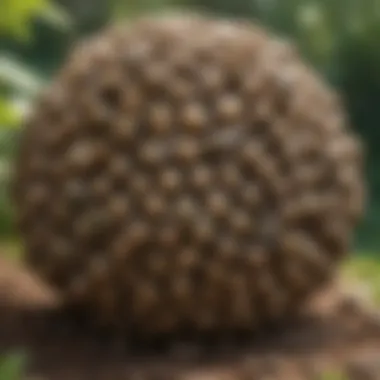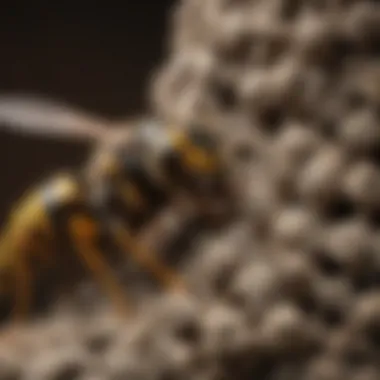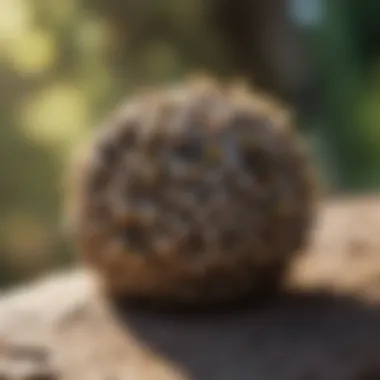Expert Guide to Wasp Nest Removal Timing and Techniques


Intro
Wasp nest removal can be a daunting task for homeowners and those who value their outdoor space. Often, these little buzzers are mistaken for bees, yet they have their own distinct characteristics and behaviors. Understanding the optimal timing and techniques for eradicating wasp nests can save you from prickly encounters and ensure your safety while managing this pesky issue.
Animal Species Profile
Prolusion to the animal species
Wasp species are diverse, with over 30,000 recognized types globally. While many are beneficial for the ecosystem by controlling pest populations and aiding in pollination, their nests can become a nuisance when constructed near human habitats.
Physical characteristics and appearance
Wasps are typically slender and long-bodied, contrasting with their bee relatives, who are rounder and fuzzier. They often sport bright yellow and black markings as a warning sign, which makes them stand out. Notable examples include the common yellow jacket and the paper wasp, which are frequently found around homes during warmer months.
Natural habitat and distribution
Wasps generally build their nests in sheltered spots. This can be in trees, shrubs, or even man-made structures like eaves and attic corners. Depending on the species, they can be found in temperate and tropical climates worldwide. Their ability to adapt to various environments makes removal essential to avoid conflicts.
Behavior and social interactions
Wasps exhibit fascinating social structures. Many species, like yellow jackets, live in colonies with a queen bee, workers, and drones. They are known for their aggressive behavior when defending their nests during peak activity periods, usually late summer and early fall. Recognizing these patterns can inform when it's safe to tackle removal efforts.
Timing for Wasp Nest Removal
Determining the right time for wasp nest removal requires careful observation. Early in the spring, nests are small and vulnerable as they are just getting started. Waiting until late summer can lead to larger nests, more aggressive wasps, and increased risk of stings. Ideally, dawn or dusk is the best time to approach a nest for removal, as wasps are less active then.
"Proper timing is half the battle when it comes to dealing with wasps. They are most predictable early in the morning or late in the evening."
Techniques for Wasp Nest Removal
Several methods can be employed for wasp nest eradication. Here’s a closer look at some reputable techniques:
- Chemical Insecticides: Many people opt for commercial sprays specifically designed for wasps. It’s vital to follow safety precautions, wearing protective gear, and applying when the wasps are less active.
- Homemade Solutions: Some prefer natural remedies like soapy water or peppermint oil, employing these as preventative measures or to neutralize small nests.
- Professional Extermination: In cases of severe infestations, hiring pest control professionals ensures thorough and safe removal. They have the experience and equipment to handle situations effectively.
- Preventative Measures: Eliminating food sources like uncovered garbage or ripe fruits in your garden can reduce wasp attraction, thus minimizing the risk of them building nests near your home.
Understanding the behavior and biology of wasps equips individuals with the knowledge to handle nests safely and effectively. With the right timing and techniques, wasp coexistence can be managed, ensuring peace of mind and safety in your outdoor spaces.
Understanding Wasp Behavior
Understanding the behavior of wasps is fundamental for anyone dealing with wasp nest removal. It provides crucial insights into the best time and methods to tackle nests safely and effectively. Knowledge about their life cycle, social structures, and seasonal habits can drastically improve the chances of a successful intervention, reducing risks to both the individual and the environment.
Lifecycle of Wasps
Wasps have a unique life cycle that unfolds in distinct stages: egg, larva, pupa, and adult. The queen starts the cycle in early spring by selecting a suitable spot to lay her eggs. This can be anywhere from under eaves to hanging from tree branches. Each egg hatches into a larva, which is fed by the queen until it pupates. Once they emerge as adults, worker wasps take over the foraging duties, bringing back food and continuing to expand the nest.
- Eggs: Tiny, often white or yellowish, laid in clusters.
- Larvae: Grub-like, requiring sustenance based on protein-rich food.
- Pupae: Encased in a protective cocoon, this stage shows development towards adulthood.
- Adults: Coordinates and manages the colony.
Each stage in their life cycle affects the nest's population, which can influence the level of aggression. Knowing these stages helps in timing removal efforts, particularly before the adults start foraging extensively. This early intervention approach can be vital for keeping disturbances minimal and reducing the chances of wasp stings.
Seasonal Activity Patterns
Wasp activity varies significantly throughout the year, and understanding these patterns aids in planning the best time for nest removal. In spring and early summer, when colonies are starting to grow, wasps are relatively less aggressive. They are focused on building their nest and gathering resources. As summer rolls into late summer and fall, colonies can become robust, which often makes them more territorial and aggressive.
- Early Spring: Queens emerge from hibernation, build nests, and lay eggs.
- Summer: Population peaks; higher aggression levels if nests are disturbed.
- Late Summer: Nests reach full size; wasps become a nuisance as they forage for sugar-rich food.
Targeting removal efforts during spring or early summer can yield optimal results, as the population is lower, and the wasps are less inclined to defend their territory.
Social Structure of Wasp Colonies
Wasp colonies operate like finely-tuned machines, governed by a complex social hierarchy. The queen is at the top, whose primary role is reproduction. Worker wasps, who are non-reproductive females, take care of foraging and defending the nest. Males, which are only present for mating, usually die off shortly after their purpose is fulfilled.
- Queen: Solely responsible for reproduction.
- Workers: Maintain the nest, gather food, and protect the colony.
- Drones: Males that are made for mating, expendables after season.
This structure influences how attacks might be coordinated if the nest is disturbed. Understanding that aggression is primarily directed by the workers can help in determining the level of risk involved during removal efforts. For anyone tackling a wasp nest removal, knowing how these social dynamics work adds layers of strategy when it comes to timing interventions and preempting defensive reactions.
"Understanding the inner workings of a wasp colony not only enhances safety but also ensures more effective techniques for removal."


Identifying Wasp Nests
Identifying wasp nests is a critical first step in the overall process of safe wasp removal. Understanding where these nests are located, and recognizing signs of their inhabitation, enables homeowners to take proactive and decisive measures. Wasp nests can potentially pose health risks, especially for individuals who are allergic to their stings. Thus, familiarity with their nesting habits can serve to protect not only the occupants of a home but also any visitors or pets.
Being able to spot a wasp nest early can reduce your own stress and potential danger. Take note that these nests can be well-camouflaged and sometimes placed in hard-to-see locations. Missing an active nest can lead to an unpleasant surprise, especially if you unwittingly disrupt the habitat of their community.
Common Locations for Nests
Wasp nests typically reflect the habitats where the species thrive. They like to find spots that are somewhat hidden but still accessible for their daily activities. Here are several commonly chosen locations:
- Under eaves and roofs: Wasps often find refuge in the sheltered overhangs of buildings. The area near a roof's edge provides both protection from the elements and a strategic vantage point for the wasps.
- Hollows in trees or shrubs: Trees with natural cavities or even thick bushes can serve as prime real estate for wasps. They often choose sites that are well-disguised from large predators.
- Inside walls or attics: Some wasp species will make their homes within walls, especially when access to attic spaces is available. The insulation and darkness offer excellent concealment.
- Utility boxes or sheds: Occasionally, a wasp nest can be found inside outdoor storage units or boxes, where they can be overlooked easily.
Identifying these locations early helps to establish not just the presence of wasps, but potentially also the safety of your environment.
Signs of Wasp Presence
So how do you know if wasps are present? Sometimes it isn’t about waiting to stumble upon the nest itself. Look for these indications:
- Increased wasp activity: Alertness to the sight of wasps buzzing around certain areas can signal nearby nests. If you notice a significant uptick in their numbers, especially close to food sources, it’s time for closer scrutiny.
- Visible nests: Scanning your surroundings can reveal the distinctive papery, oval-shaped nests. You might spot them from a distance hanging off trees or the edges of buildings.
- Panic from individuals nearby: If you’re at a gathering and people suddenly start swatting at wasps or becoming agitated, it’s likely a sign nests are near, adding urgency to your own observations.
- Unexpected wasp stings: Just one sting usually means they are not far, signaling a need for immediate attention to your vicinity.
Identifying signs of wasp presence early on not only enables a planned removal strategy but also helps in keeping you, your family, and pets safe.
"An ounce of prevention is worth a pound of cure." Knowing your environment can save you from many inconveniences down the road, particularly when it comes to these buzzing creatures.
Timing Your Removal Efforts
Getting the timing right when it comes to removing wasp nests can't be stressed enough. It's not just about getting rid of an irritation; it's about ensuring your safety and the effectiveness of your efforts. Wasps have a very specific behavior pattern throughout the seasons, and understanding these nuances can significantly boost your strategy for removal. Choosing the right moment for this task means minimizing the chance of a nasty sting or injury, while also ensuring you don’t leave any lingering threats around your home. This is where careful consideration becomes crucial.
Best Time of Year for Removal
When you think about wasp season, the late summer and early fall often come to mind. However, the most effective time for removal is actually earlier in the season, specifically late spring to early summer. During this period, nests are still in their infancy, usually not exceeding a few dozen members. Targeting a nest early can significantly lower the potential for aggressive defense by the wasps. Here’s why:
- Nest Size: In early summer, nests are smaller with fewer wasps. This makes it easier to remove the nest without drawing too much attention or aggression.
- Less Activity: Wasps tend to be less active in cooler temperatures, so the early morning or late evening, when they are trying to keep their brood warm, serves to your advantage.
- Behavioral Patterns: Young wasps are still learning the ropes; they are less aggressive compared to fully grown adults that are more experienced fighters.
Consider this: if you wait until late summer, it’s like inviting trouble into your backyard.
Time of Day Considerations
Time of day plays a significant role in wasp nest removal strategy. The golden hours for tackling this task are typically early morning and just before dusk. Why? Here’s the lowdown:
- Morning Chill: During mornings, especially before the sun has fully risen, wasps tend to be sluggish. It’s prime time to approach the nest with minimal risk since they’re less likely to confront intruders.
- Dusk Creepers: Similarly, as the sun sets and night creeps in, wasps start to settle down for the evening. This can also provide a safer window for removal.
- Avoiding Activity Peaks: Middle of the day is a no-go. Committing this blunder means facing a flurry of angry wasp activity, which can lead to painful stings.
Weather Conditions Impact
Weather does a world of good—or harm—when it comes to wasp behavior and your plans for nest removal. Wasps are cold-blooded, meaning they thrive in warm temperatures but tend to be inactive when it’s chilly. Here are some weather-related tips for effective removal:
- Calm, Clear Days: Opt for a sunny day but not too hot. A temperature between 65 and 80 degrees Fahrenheit is ideal. On such days, wasps are active but not overly aggressive.
- Avoid Windy Conditions: High winds can stir wasps into a frenzy, leading to chaotic flight behavior. If it’s breezy, hold off on your removal plans until you have a calm day.
- Post-Rainy Days: Rainy days can make for tough conditions; wasps might retreat to their nests but come out in aggression once the rain stops. It's better to wait until the day after a storm.
Important: Always check weather forecasts before planning your removal efforts. Choosing a day that aligns with friendly weather can enhance your chances of a successful and safe removal!
Safety Precautions
When tackling the issue of wasp nests, prioritizing safety precautions can't be overstated. As much as removing a nest may be necessary, the risks involved, such as painful stings and allergic reactions, are serious. People may think they can handle pests on their own, but one wrong move can lead to an encounter that leaves you scrambling for safety. Understanding the aspects of safety will equip you with the knowledge needed to approach this task wisely.
Protective Clothing Recommendations
Wearing the right protective clothing is your first line of defense against wasp stings. A long-sleeved shirt, ideally thicker fabric, can shield your arms. Trousers give protection to your legs as well. Gloves are crucial; select thick, durable ones that were designed for heavy-duty work. It's even advisable to tuck your pants into your boots or socks to minimize any exposed skin. A full-face mask or a good-quality helmet with a mesh face shield is invaluable; wasps can be persistent and will aim for your face. Here’s a checklist of clothing you should consider:
- Long-sleeved shirts and long pants
- Thick gloves
- Boots or closed-toe shoes
- Facial protection
- Headgear, if possible
Essential Safety Gear
Beyond just clothing, additional safety gear can further ensure your well-being during nest removal. With safety in mind, consider these items:
- Insect Repellent: A good insect repellent can keep wasps at bay during your mission.
- Emergency First Aid Kit: Having one on hand is wise—think basic remedies for stings or allergic reactions.
- Sting Relief Cream: Special care for those unexpected stings can make the pain much more manageable.
- Communication Device: Make sure someone nearby knows what you're doing and can assist if things go awry.


These pieces of gear bolster your confidence, knowing that you’re better prepared for the event of unexpected encounters or accidents.
Emergency Preparedness
Preparing for emergencies, while perhaps less exciting, is critical. Prior to starting the work, familiarize yourself with your surroundings; know where you can find medical assistance quickly. If there are people with known allergies to stings around, it may be more prudent to seek professional help.
Establish a plan of action in case of a wasp attack. For instance, you can:
- Set a designated escape route away from where the nest is situated.
- Have someone on standby who can help if needed.
- Learn basic first aid for stings, preferably knowing how to use an EpiPen if it comes to that.
"Vigilance and preparedness are your best allies when it comes to any removal efforts with wasps. It’s not just about the removal; it’s about doing so in a way that doesn’t jeopardize your safety."
Taking these precautions goes a long way in not only ensuring your safety but also in making the entire process less stressful. Riding the line between caution and action allows you to face this situation appropriately while minimizing risk.
Methods for Removing Wasp Nests
Successfully removing a wasp nest is no small feat. The methods employed for this task are crucial, impacting not only the effectiveness of the removal but also the safety of those involved. Different removal techniques cater to various situations, weighing each method's efficiency against potential downsides. Understanding the nuances of chemical solutions, natural remedies, and professional services is essential for any homeowner or enthusiast dealing with wasps.
Chemical Solutions
When addressing wasp infestations, chemical solutions often present a straightforward option. Many commercial pesticides are designed specifically for targeting wasps, offering rapid results. The allure of these products lies in their ease of use, even for novices.
Key benefits of chemical solutions include:
- Immediate action: Many chemical sprays knock down the insects quickly, greatly reducing immediate danger.
- Thorough poisoning: It’s not just the wasps within the nest that are affected; foraging wasps can also be targeted, which is crucial during peak activity.
- Wide availability: Most local hardware stores carry a variety of suitable products.
However, it’s important to approach these with caution. Repeated use can harm beneficial insects, and residue often lingers, impacting the surrounding ecosystem. Always read instructions thoroughly, ensuring you wear appropriate protective gear when applying any pesticide.
"Responsibly removing wasp nests requires a balance. Don't sacrifice the environment for effectiveness."
Natural Remedies
For those leaning towards an eco-friendly option, natural remedies offer a compelling alternative. While they may not promise the expedited results of chemicals, they present a milder approach that aligns with many animal lovers' values. Common natural solutions include:
- Vinegar traps: Mixing equal parts vinegar and sugar can lure wasps into a trap, effectively reducing their numbers. These traps can be easily set in strategic spots around your home.
- Essential oils: Oils like peppermint or clove have shown effectiveness at repelling wasps, without harming them. Spraying a diluted solution in affected areas deters further nesting.
- Soap and water solution: A mixture of soap and water can also suffocate the insects upon contact.
While natural remedies minimize the harmful impact on the environment, they do require patience. They may take longer to achieve desired results compared to their chemical counterparts. It’s recommended to try these methods during early mornings or evenings when wasps are least active.
Professional Pest Control Services
Sometimes, the safest and most effective course of action is to call in the experts. Professional pest control services come equipped with knowledge and tools that most homeowners lack. These specialists understand wasp behavior and possess tailored solutions that can be far more effective than DIY approaches.
Reasons to consider professional services include:
- Experience: Experts know how to assess the situation accurately, whether it be the size of the colony or the complexity of the nest location.
- Advanced techniques: Professionals often have access to methods and pesticides not available to the general public, leading to a more effective eradication of the problem.
- Safety assurance: The threat of being stung is significantly reduced when professionals are handling the situation. Their training helps them navigate safely around active nests.
In summary, the removal of wasp nests can be approached in several ways, each with its strengths and weaknesses. Balancing efficiency with safety and environmental impact involves careful consideration of the right method for each specific scenario.
Post-Removal Considerations
After successfully removing a wasp nest, there are essential steps to follow that ensure not only the effectiveness of your efforts but also the long-term safety and comfort of your surroundings. Addressing the aftermath of wasp nest removal is vital to preventing a recurring issue and safeguarding your outdoor spaces.
Cleaning the Area
Once the nest has been dealt with, it's important to thoroughly clean the area where the nest was situated. This action helps eliminate any lingering pheromones that could attract new wasps. Wasps communicate through scents, and traces of the nest may signal to other wasps that this spot is suitable for nesting.
Here are steps to guide you through cleaning the area:
- Remove Nests Residue: Carefully clear away any remnants of the nest using gloves.
- Dispose of Debris: Use a sealed plastic bag to discard the remnants properly.
- Scrub the Surface: Utilize a scrub brush and a mixture of vinegar and water, which not only cleans but also disrupts any enticing scents.
- Inspect Surroundings: Check for any potential nesting sites nearby, like dense shrubs or unutilized corners, and address them appropriately.
Regular maintenance of the area can keep it less attractive to wasps.
Preventing Future Nests
Prevention is always better than cure, especially when it comes to wasps. After removing a nest, several strategies can minimize the risk of future infestations. Recognizing and adapting your environment can be the key to ensuring that your space remains wasp-free.


Key preventative measures include:
- Seal Entry Points: Check for and repair any holes or gaps in siding, eaves, and roofs that could serve as entry points for future nests.
- Remove Food Sources: Wasps are drawn to food. Ensure that garbage is covered, pet food is stored inside, and fruit trees are regularly tended to.
- Use Wasp Deterrents: Natural remedies, like peppermint oil, can act as a repellent. Mix a few drops with water in a spray bottle and apply near areas where wasps might appear.
- Maintain Landscaping: Trim back overgrown bushes or trees that provide shelter for wasps. Keeping plants well-maintained can reduce the likelihood of a nest forming nearby.
By implementing these post-removal strategies, you not only safeguard your space but also create an environment less inviting to these stinging insects.
When to Seek Expert Help
Understanding when it's necessary to call in the professionals is crucial in the realm of wasp nest removal. While many homeowners may attempt to tackle the problem themselves, certain situations arise where nuance and expertise are indispensable. In this section, we will delve into the elements that underline the need for expert assistance, highlighting key benefits and considerations.
A significant factor that affects your decision to seek expert help is the potential risks associated with wasps. Unlike honeybees, wasps are notorious for their aggressive behavior, especially when they sense a threat to their nest. If you're dealing with allergy sufferers in your household, a sting could potentially result in severe allergic reactions or anaphylaxis. In such instances, the stakes are high, making it clear why some situations call for specialists equipped with the knowledge and gear to manage such risks safely.
Another important point is the identification of the type of wasp. Not all wasps behave the same way or are situated in the same contexts. Depending on the species involved, removal tactics may differ. Professionals are trained to recognize these distinctions, which can significantly affect the approach and therefore increase the chances of a successful eradication.
"Not all nests are created equal; professional pest control experts can evaluate the landscape and determine the best strategy for removal."
Identifying High-Risk Situations
When evaluating high-risk situations, several factors should be taken into account. For starters, the nest's location plays a vital role. If the nest is nestled in a high-traffic area—think overhanging branches above a porch or right beside a door—then the risk of encountering wasps increases. You might think you can take a quick crack at it, but one wrong move can provoke an angry swarm.
Additionally, the size of the nest provides critical insight. A small nest may seem manageable, but if it looks like a small soccer ball, that’s a whole different ball game. Large nests often indicate a well-established colony, which could mean higher wasp populations. Engaging a professional can provide peace of mind and targeted strategies for effective removal.
Evaluating Nest Size and Location
When it comes to evaluating the size and location of a wasp nest, the first step is to observe from a safe distance. Is the nest small enough to consider handling on your own, or does it appear sizable and intricate? Usually, nests larger than a grapefruit suggest that it's best to leave the job to pros.
Location factors heavily into the decision as well. Wasps prefer building nests in sheltered spots, such as under eaves, in attics, or even within the walls of homes. If you find a nest in an awkward or hard-to-reach location, it’s a sign that expert intervention may be the safest route.
Legal and Environmental Considerations
Addressing the removal of wasp nests isn't merely about eliminating a nuisance; it intersects with legal and environmental frameworks that govern pest control methods. Understanding these considerations is crucial for safe and responsible wasp management. Overlooking local regulations could lead to potential legal consequences, not to mention an unnecessary upheaval in local ecosystems where wasps play a vital role.
Local Regulations on Wasp Nest Removal
Laws surrounding wasp nest removal can vary dramatically from one locality to another. Some municipalities may require homeowners to obtain permits to remove nests or collaborate with licensed pest control operators. Hence, it’s important to consult your local regulatory body or pest control associations.
Key points to consider:
- Permits and Fees: In some localities, a permit is necessary for removing nests that are classified under certain animal protection laws.
- Notification Requirements: Certain regions might have rules requiring you to notify local wildlife agencies if you encounter a nest.
- Prohibitions on Insecticides: Restrictions may also be in place regarding certain chemical treatments deemed harmful to wildlife.
These regulations are designed for a good reason. They aim to protect not just the wasps, but also other pollinators and beneficial insects that share the same environment. Ignoring these protocols isn't just bad practice—it's unlawful in many areas.
Impact on Local Ecosystems
Wasps are often painted as purely aggressive pests, but they contribute to the local ecology in significant ways. They serve as predators for many undesirable insects, thereby helping to maintain the health of gardens and farms. Removing a wasp nest can disrupt this natural balance, potentially leading to an overpopulation of pests that the wasps once kept in check.
When engaging in nest removal, consider these ecological impacts:
- Pollination Assistance: Though not widely recognized, many wasps contribute to plant pollination. Their removal might affect local flora that relies on them.
- Food Source for Other Wildlife: Wasps are a food source for various birds and other animals. Removing them could have a cascading effect on local wildlife populations.
- Pest Population Dynamics: Without wasps, pest populations may surge, leading to an increased need for chemical pest control, which further harms the ecosystem.
The goal isn’t to create a fear-driven response to wasps, but rather to foster an understanding of their role within the ecosystem. In summary, any approach to wasp nest removal requires careful consideration of legalities and environmental responsibilities. With the right knowledge, it's possible to manage wasp populations effectively while honoring the balance of nature.
"Nature has a way of balancing itself. Disrupting one element could lead to unforeseen consequences in another."
Finale
Navigating the complex world of wasp nest removal can be daunting, but as this article illustrates, proper timing and knowledge are fundamental to success. Understanding when to tackle a nest and employing the right techniques can save individuals from unnecessary stings and frustration, making the process less hazardous and more efficient.
Recap of Key Insights
Throughout our exploration, we have encountered various takeaways that are essential for anyone considering wasp nest removal:
- Lifecycle Awareness: Grasping the development stages of wasps enhances the chance of effective removal. Knowing how nests grow can influence your timing significantly.
- Seasonal Patterns: The time of year plays a vital role in wasp behavior. By choosing late evening in late summer or early fall, when wasp activity wanes, the risk of confrontation reduces.
- Safety First: Always prioritize safety. Wearing protective gear, like beekeeping suits or gloves, is crucial. Being prepared for emergencies is also vital; stings can be severe for allergic individuals.
- Methods of Eradication: Whether opting for chemical solutions, natural remedies, or professional services, understanding the methods available allows for informed decision-making based on personal comfort and environmental considerations.
"Effective wasp management combines knowledge, strategy, and respect for nature's balance."
Final Thoughts on Wasp Nest Management
Managing wasp nests isn’t solely about eradicating a problem. It involves a deeper understanding of these insects' roles in the ecosystem. Wasps contribute to pollination and pest control, indicating the need for a balanced approach. In some cases, it might be better to consider deterrent methods instead of immediate removal.
It’s also wise to stay aware of local regulations regarding wasp nest removal, as some areas may impose restrictions due to environmental concerns. The desire to maintain harmony with local wildlife can enhance one's garden or outdoor experience, at the same time reducing the urge to eradicate without reason.







